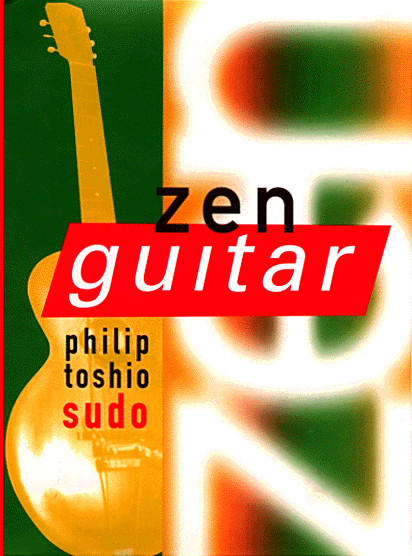

From The Albuquerque Journal, Feb. 2, 1997
By Michael Haederle
Zen is a hot marketing tool these days. The alternative band Bush had a hit song last year called "Everything Zen." A publisher recently saw fit to release an illustrated collection of aphorisms called "Zen for Sheep," and a few years back there was the memorable paperback release, "Zen Driving." Blame it on the Beats, who made Zen cool.
What such productions share is a catchy title (Zen is supposed to be hip and enigmatic), but they typically have very little to do with Zen or deal with it only superficially.
So a reader might be forgiven for being wary about Zen Guitar. What a pleasant surprise to find that Philip Toshio Sudo has done his homework. He demonstrates a solid understanding of Zen, but for the guitar player looking for playing tips, what Sudo has to say may come as a bit of a letdown.
There is very little about this book that is intrinsically about playing the guitar. Sudo does not discuss technique in the usual sense--say, string-bending or staccato picking. He seldom mentions particular instruments or amplifiers and doesn't favor or exclude any particular type of music.
What he's trying to convey is the need for a player to manifest a particular kind of conciousness each time he or she picks up the instrument. It would be tempting to call this a philosophy of guitar playing, but for Sudo it's more than that. It's all about putting one's understanding into practice, moment by moment.
That said, the book really isn't "about" Zen, either. While it introduces a lot of Zen terms and concepts, it doesn't attempt to offer an overview of Zen or Buddhism. It's more a concrete demonstration of how ego-free Zen conciousness can permeate any activity.
That idea was well understood when Zen took hold in medieval Japan and came to permeate the entire culture. Swordsmanship, archery, painting, flower arranging, drama and the tea cermony were all seen as vehicles for expressing the Buddhist understanding of "no-self."
A student of guitar and martial arts, Sudo presents his message the way a karate master might. The book is his dojo; readers are students.
The book moves from the white belt stage, where students recognize their "beginner's mind," through the transition to black belt, the point where technical excellence is attained. But it doesn't stop there. The way of the Zen guitarist is to move beyond black belt and return to the fresh perspective of the beginner.
Each chapter opens with a quotation from a musician--e.g. Jimi Hendrix, Andrés Segovia--that illustrates Sudo's point. They are presented in the order in which a player might develop, treating in turn spirit, rhythm, technique, feel, perfection, mistakes, and so on.
Sudo also has much to say about how ego and self-doubt mar many players' performances. He writes, "One should strive to make sound with the purity of a bird in the wild--that is the Way of Zen Guitar."
--Michael Haederle is a freelance writer living in Alameda.